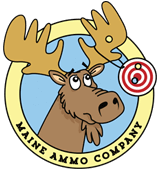The .44 Remington Magnum, or simply .44 Magnum (10.9×33mmR), and frequently .44 Mag, is a large-bore cartridge originally designed for revolvers. After its introduction, it was quickly adopted for carbines and rifles. Despite the “.44” designation, guns chambered for the .44 Magnum round, and its parent, the .44 Special, use 0.429 in (10.9 mm) diameter bullets.
The .44 Magnum is based on a lengthened .44 Special case, loaded to higher pressures for greater velocity (and thus, energy). The .44 Magnum has since been eclipsed in power by the . Casull, and most recently by the .460 S&W Magnum and .500 S&W Magnum, among others; nevertheless, it has remained one of the most popular commercial large-bore magnum cartridges. When loaded to its maximum and with heavy, deeply penetrating bullets, the .44 Magnum cartridge is suitable for short-range hunting of all North American game—though at the cost of heavy recoil and muzzle flash when fired in handguns, less so in carbines and rifles.
The .44 Magnum cartridge was the end result of years of tuned hand loading of the .44 Special. The .44 Special, and other large-bore handgun cartridges, were being loaded with heavy bullets, pushed at higher than normal velocities for better hunting performance. One of these handloaders was Elmer Keith, a writer and outdoorsman of the 20th century
Elmer Keith settled on the .44 Special cartridge as the basis for his experimentation, rather than the larger .45 Colt. At the time, the selection of .44 caliber projectiles for handloaders was more varied, and .44 special brass was thicker and stronger than the dated .45 Colt case. Also, the .44 Special case was smaller in diameter than the .45 Colt case. In revolvers of the same cylinder size, this meant the .44 caliber revolvers had thicker, and thus stronger, cylinder walls than the .45. This allowed higher pressures to be used with less risk of a burst cylinder.
Keith encouraged Smith & Wesson and Remington to produce a commercial version of this new high-pressure loading, and revolvers chambered for it. Smith & Wesson’s first .44 Magnum revolver, the Model 29, was built on December 15, 1955, and the gun was announced to the public on January 19, 1956 for a price of $140. Julian Hatcher, (technical editor of American Rifleman) and Elmer Keith received two of the first production models. Hatcher’s review of the new Smith & Wesson revolver and the .44 Magnum cartridge appeared in the March, 1956 issue of the magazine. Smith & Wesson produced 3,100 of these revolvers in 1956.
By the summer of 1956, Sturm, Ruger became aware of this project and began work on a single action Blackhawk revolver for the new .44 Magnum cartridge. Popular rumor says a Ruger employee found a cartridge case marked “.44 Remington Magnum” and took it to Bill Ruger, while another says a Remington employee provided Ruger with early samples of the ammunition. Ruger began shipping their new revolver in late November, 1956.
The .44 Magnum case is slightly longer than the .44 Special case, not because of the need for more room for propellant, but to prevent the far higher pressure cartridge from being chambered in older, weaker .44 Special firearms, thus preventing injuries and possible deaths.
The .44 Magnum was an immediate success, and the direct descendants of the S&W Model 29 and the .44 Magnum Ruger Blackhawks are still in production, and have been joined by numerous other makes and models of .44 Magnum revolvers and even a handful of semi-automatic models, the first being produced in the 1960s. The film “Dirty Harry“, prominently featuring the S&W M29, contributed to that model’s popularity (as well as the cartridge itself).
Ruger introduced its first long gun, a semi-automatic carbine called the Ruger Model 44 chambered for .44 Magnum, in 1959. Marlin followed soon after with a lever action Model 1894 in .44 Magnum. Having a carbine and a handgun chambered in the same caliber is an old tradition; the .44-40 Winchester was introduced by Winchester in a lever action in 1873, and Colt followed in 1878 with a revolver in the same caliber. The .38-40 Winchester and .32-20 Winchester were also available in both carbines and revolvers, allowing the shooter to use one type of ammunition for both firearms.
Although improved modern alloys and manufacturing techniques have allowed even stronger cylinders to be made, leading to larger and more powerful cartridges such as the .454 Casull and .480 Ruger in revolvers the same size as a .44 Magnum, the .44 Magnum is still considered an exceptional weapon. In 2006, to commemorate the 50th anniversary of the .44 Magnum, Ruger introduced a special 50th anniversary Blackhawk revolver, in the “Flattop” style

